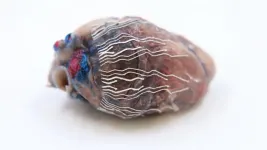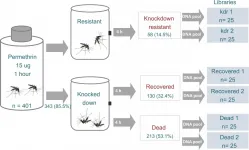(Press-News.org) Woodlands along streams and rivers are an important part of California's diverse ecology. They are biodiversity hotspots, providing various ecosystem services including carbon sequestration and critical habitat for threatened and endangered species. But our land and water use have significantly impacted these ecosystems, sometimes in unexpected ways.
A team of researchers, including two at UC Santa Barbara, discovered that some riparian woodlands are benefitting from water that humans divert for our own needs. Although it seems like a boon to these ecosystems, the artificial supply of water begets an unintended dependence on this bounty, threatening the long-term survival of natural forest communities. The paper, published in the Proceedings of the National Academy of Sciences, spotlights the need for changes in the way water is managed across the state.
"We need to be more intentional in incorporating ecosystem water needs when we manage water--both for aquatic organisms and species on land," said lead author Melissa Rohde, a groundwater scientist at The Nature Conservancy who led the research as a doctoral student at State University of New York College of Environmental Science and Forestry (SUNY-ESF). "These forest ecosystems are in a precarious state because we have disrupted the natural hydrologic processes that these plant species rely upon to support and sustain key life processes."
In California's Mediterranean climate, plants and animals have adapted to rely on precipitation and soil moisture recharge during the rainy winter and spring seasons for reproduction and growth during the typically dry summers. Once soil moisture is exhausted, tree species often found in stream corridors, such as willows, cottonwoods and oaks, typically use deeper groundwater. However, the researchers discovered the story was more complicated.
By analyzing five years of vegetation greenness data from satellite imagery, the authors found that in some cases, these ecosystems were affected by "subsidies of water" delivered via human regulation of rivers, agricultural canals and discharges from wastewater treatment plants. Altered streamside woodlands in the most arid regions of the state stayed greener longer into the dry season and were less responsive to changes in groundwater levels than natural ecosystems.
"Although this seems like a good news story -- trees benefit from anthropogenic water management -- there is an important caveat," said co-author Michael Singer, a researcher at UC Santa Barbara's Earth Research Institute and a professor at Cardiff University in the United Kingdom. "In channels and canals with severely altered flow regimes, there are few if any opportunities for these trees to spawn new offspring. This means that once these riparian woodlands die off, they will not be replaced through forest succession."
Many of the most-altered stream ecosystems are in California's Central Valley, the state's agricultural hub, which produces a third of the produce for the United States. Following the Gold Rush in the 1850s, massive human settlement led to clearing of 95% of the natural floodplain woodlands across the region. These isolated and restricted riparian, or streamside, forests now provide important habitat for threatened and endangered species like the California red-legged frog, Chinook salmon and Swainson's hawk.
As water is rerouted from rivers into canals to accommodate urbanization and the multibillion-dollar agricultural industry, it creates an artificially stable environment for riparian woodland ecosystems. This encourages a "live fast, die young" community that favors trees that peak and then decline within a few decades. Key ecosystem functions -- such as the regeneration of new forest stands and their development over time -- are being compromised by the extensive alterations to streamflow and to river channels, which are fixed in place and no longer create new floodplain areas where young trees can establish.
"We call these forests the 'living dead' because the forest floor is devoid of saplings and younger trees that can replace the mature trees when they die," Rohde said. This has repercussions related to habitat for endangered species, biodiversity, carbon sequestration and climate change.
"California is one of the most biodiverse regions in the world, containing more species than the rest of the United States and Canada combined," said Rohde. "In the midst of the sixth mass extinction, the long-term sustainability of California's river ecosystems and the preservation of the rare and endemic species that live within them now rely on the deliberate, coordinated management of resource and government agencies."
This study is part of a $2.5 million suite of projects that the collaborators at SUNY-ESF, UC Santa Barbara and Cardiff University have funded throughout the U.S. Southwest and France. The investigators also include UCSB geography professor Dar Roberts, one of the study's co-authors. The goal is to develop water stress indicators for dryland riparian forest ecosystems threatened by climate change and increasing human water demand.
Rhode and The Nature Conservancy will use the insights from the study to provide scientific guidance to California natural resource agencies for sustainably managing groundwater-dependent ecosystems throughout the state. As Singer pointed out, the findings pertain to the recent sustainable groundwater legislation passed in California. The Sustainable Groundwater Management Act, requires all groundwater stakeholders to agree on sustainability targets for groundwater usage to support urban areas, agriculture, industry and ecology.
The research team used publicly available online data and Google Earth Engine, an open-source tool for analyzing data from satellites and other global spatial datasets. "Our methods and findings open up a whole new world of interdisciplinary research possibilities and ways that water practitioners can consider ecosystem water needs to achieve sustainable water management," Rohde said.
John Stella, a SUNY-ESF professor and principal investigator on the National Science Foundation grant that funded the study, characterized the work as "groundbreaking" for the way it "combined several big datasets in an innovative way to understand how climate and water management interact to put these sensitive ecosystems at risk."
"[The] findings are important for sustainably managing groundwater, not only throughout California, but in water-limited regions worldwide," Stella said. "By creatively harnessing and integrating these large environmental datasets, we can now answer resource management questions at a scale that was previously impossible."
INFORMATION:
SAN ANTONIO (June 17, 2021) -- Middle-aged people with depressive symptoms who carry a genetic variation called apolipoprotein (APOE) ε4 may be more at risk to develop tau protein accumulations in the brain's emotion- and memory-controlling regions, a new study by researchers from The University of Texas Health Science Center at San Antonio (UT Health San Antonio) and collaborating institutions suggests.
The Journal of Alzheimer's Disease published the findings in its June 2021 print issue. The research is based on depression assessments and positron emission tomography (PET) imaging conducted among 201 participants in the multigenerational Framingham Heart Study. The mean age of these participants was 53.
Decades before diagnosis
PET scans typically are conducted ...
LOS ALAMOS, N.M., June 17, 2021 -- A research team from Los Alamos National Laboratory and Purdue University have developed bio-inks for biosensors that could help localize critical regions in tissues and organs during surgical operations.
"The ink used in the biosensors is biocompatible and provides a user-friendly design with excellent workable time frames of more than one day," said Kwan-Soo Lee, of Los Alamos' Chemical Diagnostics and Engineering group.
The new biosensors allow for simultaneous recording and imaging of tissues and organs during surgical procedures.
"Simultaneous recording and imaging could be useful during heart surgery in localizing critical regions and guiding surgical interventions such as a procedure for restoring normal ...
Nanodecoys made from human lung spheroid cells (LSCs) can bind to and neutralize SARS-CoV-2, promoting viral clearance and reducing lung injury in a macaque model of COVID-19. By mimicking the receptor that the virus binds to rather than targeting the virus itself, nanodecoy therapy could remain effective against emerging variants of the virus.
SARS-CoV-2 enters a cell when its spike protein binds to the angiotensin-converting enzyme 2 (ACE2) receptor on the cell's surface. LSCs - a natural mixture of lung epithelial stem cells and mesenchymal cells - also express ACE2, making them a perfect vehicle ...
Current approaches for planning relocation for potentially millions of people affected by climate change and related risks are "woefully inadequate" and risk worsening societal inequities, experts wrote in a policy perspective on June 17 in Science. Policymakers and scientists need to rethink how they work together to develop, communicate and carry out relocation plans.
"Relocation involves moving people away from risk and into totally new settings," said the team of experts led by Richard Moss. Moss is a Gerhard R. Andlinger Visiting Fellow at Princeton's Andlinger Center ...
The Yellow fever mosquito (scientific name, Aedes aegypti) spreads multiple untreatable viruses in humans and is primarily controlled using a pesticide called permethrin. However, many mosquitoes are evolving resistance to the pesticide. A new study by Karla Saavedra-Rodriguez of Colorado State University and colleagues, published in the journal PLOS Genetics, identifies mutations linked to different permethrin resistance strategies, which threaten our ability to control disease outbreaks.
When treated mosquitoes encounter permethrin in the wild, they will do one of the following: immediately die, be knocked out but recover, or be unaffected. Saavedra-Rodriguez and her colleagues decided to investigate the genetic variations that lead to these ...
A new treatment approach focused on fixing cell damage, rather than fighting the virus directly, is effective against SARS-CoV-2 in lab models.
Combination of two drugs reduces spread of SARS-CoV-2 infection in cells by up to 99.5%.
If found safe for human use, this anti-viral treatment would make
COVID-19 symptoms milder and speed up recovery times.
When a person is infected with SARS-CoV-2, the virus that causes COVID-19, it invades their cells and uses them to replicate - which puts the cells under stress. Current approaches to dealing with infection target the virus itself with antiviral drugs. But ...
Patents with all-female inventor teams are more likely than all-male teams to address problems that specifically or disproportionately affect women, according to a new study. The findings, derived from an analysis of more than 440,000 U.S. biomedical patents filed from 1976 to 2010, suggest that who benefits most from innovation largely depends on who gets to invent. While the gender gap in research and innovation is well known, its broader impact on what gets invented - and for whom - isn't well understood. To address this question, Rembrand Koning and colleagues used machine learning text analysis to evaluate all U.S. biomedical patents filed from 1976 to 2010. They found that patents ...
Daunting and uncertain is the future for people who must decide whether, where, when, and how to vacate their homes as the climate changes. Communities who will absorb this influx of uprooted people also face challenges. In a special issue of Science, "Fallback Strategies: Planning for Climate-Induced Relocation," experts examine ways in which interdisciplinary basic and applied research can - and must - engage with and support communities and governments navigating this landscape. As this work is done, "we must consider not only what science can do, but how science ...
Using LIGO's suspended mirrors, researchers have demonstrated the ability to cool a large-scale object - the 10-kilogram optomechanical oscillator the suspended mirrors form - to nearly the motional quantum ground state. Upgrading LIGO (Laser Interferometer Gravitational-Wave Observatory) with such a modification would not only increase the device's sensitivity and range in detecting gravitational waves but could also provide new insights into large-scale quantum phenomena. For most mechanical objects to be coaxed into a quantum state, they need to be cooled to exceedingly low temperatures to overcome the thermal vibrations, or phonons, that mask the signature of quantum motion. This brings the ...
Marine-terminating glaciers may be less vulnerable to rapid and irreversible collapse than previously suggested, according to a new study, which finds that ice cliff collapse is limited by upstream thinning of the ice sheet and how quickly calved icebergs and sea-ice float away. The glaciers of Greenland and Antarctica slowly flow to the sea, terminating in massive vertical ice cliffs. Occasionally, these partially submerged margins can collapse under their own weight and trigger rapid disintegration of ice sheets. It's thought that this process, called marine ice cliff instability (MICI), could lead to the catastrophic retreat of some of the planet's largest ice sheets, substantially contributing to global sea level rise. However, current ...


